|
The Rhätische Bahn

A Rhätische Bahn train with two Alpine Classic Pullman Express cars approaches Bergün
Switzerland.
 Rhätische Bahn Rhätische Bahn
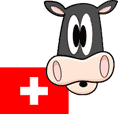 The Rhaetian Railway, Rhätische Bahn in German, Ferrovia Retica in Italian, and Viafier
Retica in Romansh is abbreviated RhB. It is a modern, well maintained, frequent, and clean metre gauge (3 feet 3 3/8 inches),
adhesion and rack railway, mostly electric (there are some diesel powered locomotives). The Pontresina to Tirano section is
electrified with 1,000 Volts DC. Other portions are electrified at 11 Kilo Volts 16 2/3 Hertz including the Chur-Arosa line and
the new Vereina tunnel route. The network contains 84 tunnels, the longest being the 19.042 kilometre (11.832 miles) Vereina
Tunnel opened on 19 Nov 1999, and the 5.864 kilometre (3.644 mile) Albula Tunnel. There are 383 bridges in total. The maximum
gradient is 4.5 percent except on the Bernina line where it is 7 percent. The network lies primarily in the canton of
Graubünden, the capital of which is Chur (pronounced koor, like the American beer, minus the "s"). The company's
headquarters is located in Chur. The map below shows the canton of Graubünden with the Rhätische Bahn lines included on
it. However, it does not show any Swiss standard gauge or bus lines which significantly enhance transportation possibilities
within the canton. The Rhaetian Railway, Rhätische Bahn in German, Ferrovia Retica in Italian, and Viafier
Retica in Romansh is abbreviated RhB. It is a modern, well maintained, frequent, and clean metre gauge (3 feet 3 3/8 inches),
adhesion and rack railway, mostly electric (there are some diesel powered locomotives). The Pontresina to Tirano section is
electrified with 1,000 Volts DC. Other portions are electrified at 11 Kilo Volts 16 2/3 Hertz including the Chur-Arosa line and
the new Vereina tunnel route. The network contains 84 tunnels, the longest being the 19.042 kilometre (11.832 miles) Vereina
Tunnel opened on 19 Nov 1999, and the 5.864 kilometre (3.644 mile) Albula Tunnel. There are 383 bridges in total. The maximum
gradient is 4.5 percent except on the Bernina line where it is 7 percent. The network lies primarily in the canton of
Graubünden, the capital of which is Chur (pronounced koor, like the American beer, minus the "s"). The company's
headquarters is located in Chur. The map below shows the canton of Graubünden with the Rhätische Bahn lines included on
it. However, it does not show any Swiss standard gauge or bus lines which significantly enhance transportation possibilities
within the canton.
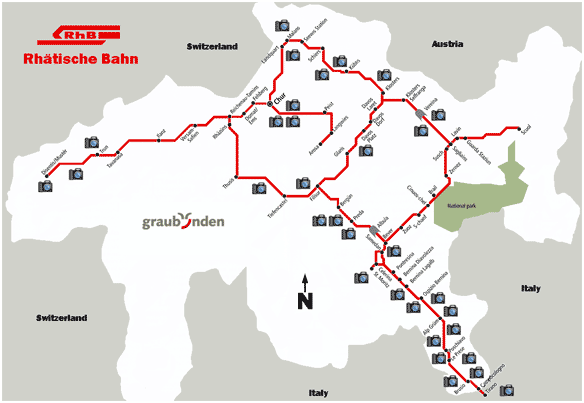
Click on the map to enlarge
it then click on any camera icon to view a photo, or photos, at that location.
 Grade Charts Grade Charts
There are two grade charts. The first shows the mainline grades around Chur while
the second displays the line to Tirano.
 A Brief History A Brief History
 Construction of the first railway in the canton of Graubünden
occurred in 1888 when the narrow gauge Landquart-Davos Railway was created by a local businessman. A year later this line was
opened with steam engines working as far as Klosters. One year later the line reached Davos. Construction of the first railway in the canton of Graubünden
occurred in 1888 when the narrow gauge Landquart-Davos Railway was created by a local businessman. A year later this line was
opened with steam engines working as far as Klosters. One year later the line reached Davos.
The Davos-Filisur section opened in 1909 ensuring a connection with the Albula Railway. In 1896 the line reached Thusis, in 1903
Celerina, and finally in 1904 Saint Moritz. This became the main line connecting Chur, Thusis, Filisur, Albula, and Saint Moritz.
One of the best known viaducts on this route is the Landwasser viaduct near Filisur which was completed in 1902.
From the Albula main line various branches spread out in all directions. The Chur-Thusis section and the connection with the Davos
line at Landquart were opened at the same time.
 In 1903, the line to Illanz was completed and extended to Disentis by 1912.
In 1903, the line to Illanz was completed and extended to Disentis by 1912.
A branch line to Scuol was put into operation in 1913.
When the Albula line was under construction between 1896 and 1904 electric traction was still in its infancy. Trial runs between
1904 and 1909 using a single phase low-frequency alternating current (AC) system proved electric traction could be practical. The
RhB then decided to operate the St. Moritz-Scuol line using single-phase alternating current of 11 Kilovolts at 16 2/3 Hertz.
This installation proved so successful that the RhB electrified its other lines between 1919 and 1922.
The RhB network has continued to make improvements over the years and on 19 Nov 1999 the Vereina tunnel was opened.
Currently the RhB is the largest network of all the private railways in Switzerland. The Swiss Federal Railways SBB, CFF, and FFS,
extend only a few kilometres over the cantonal border into the capital at Chur.
In 2008 the Albula and Bernina lines were added to the list of UNESCO World Heritage Sites.



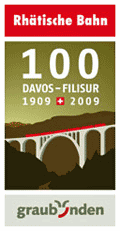
 Landwasser Viaduct Landwasser Viaduct
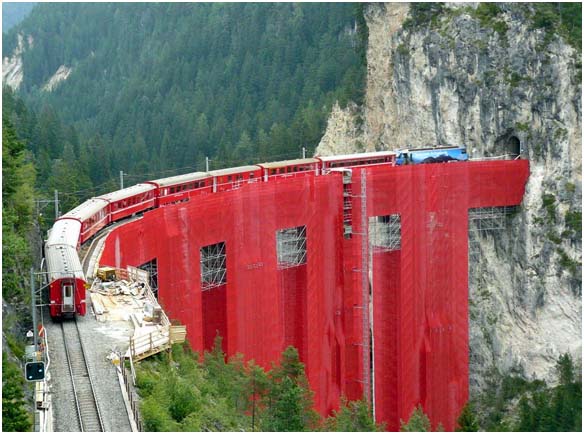
The
Landwasser Viaduct was built between March 1901 and October 1902 by Müller and Zeerleder of Zurich. It contains 9,200 cubic
metres of brick work, 200,000 man-hours were employed in its construction, and cost 280,000 francs ($341,600 at the present
exchange rate) to build. It can bear loads of up to a thousand tons. It is a technological masterpiece. Its revolutionary design
and the way it was built both ensure it will remain a landmark. For reasons of cost, the pillars were built without the use of scaffolding. This was done by adding
brick work to integral cast iron towers. The viaduct crosses the Landwasser River at a height of 65 metres ( 213 feet). It follows
a curve with a radius of just 100 metres (328 feet) in order to adapt it to the contours of the sheer rock walls at both ends. The
142-metre (466 feet) long structure consists of five pillars and six semicircular arches, each one spanning 20 metres (66 feet).
The Landwasser Viaduct is of unique design and is a living monument to Swiss railway history.
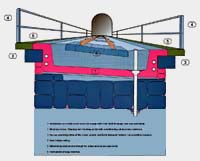 The viaduct is in good condition considering it has been standing for 109 years, long enough for wear to become apparent in the
brick work and pointing. This is caused by changes in temperature and the infiltration of water. In 2009 it underwent a renovation
to bring it into top condition. All the mortar between the bricks was re-pointed and new ballast was applied to the track.
Completion took 9 months (March 2009 to November 2009) with 15 construction experts and 24,000 man-hours while 60 trains per day
continued to cross. A quarter of the work was carried out at night using auxiliary bridge sections in order to maintain train
services. Total rehabilitation cost was 4.6 million francs ($5.6 million).
The viaduct is in good condition considering it has been standing for 109 years, long enough for wear to become apparent in the
brick work and pointing. This is caused by changes in temperature and the infiltration of water. In 2009 it underwent a renovation
to bring it into top condition. All the mortar between the bricks was re-pointed and new ballast was applied to the track.
Completion took 9 months (March 2009 to November 2009) with 15 construction experts and 24,000 man-hours while 60 trains per day
continued to cross. A quarter of the work was carried out at night using auxiliary bridge sections in order to maintain train
services. Total rehabilitation cost was 4.6 million francs ($5.6 million).
All structures on the Albula and Bernina lines have been part of the UNESCO World Heritage site since July 2008. This means that
nothing could be changed with respect to the outer appearance of the viaduct.
 Brusio Circular Viaduct Brusio Circular Viaduct
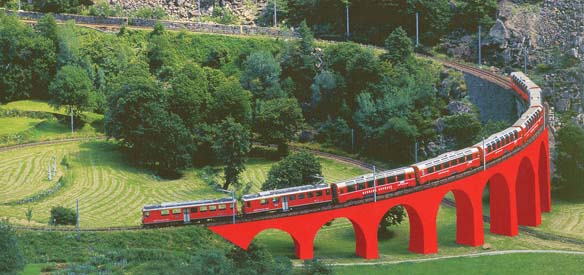
This re-touched photo shows what the Brusio circular viaduct might look like during renovation
in 2011.
The circular viaduct at Brusio lies between Saint Moritz, Switzerland, and Tirano,
Italy. The engineers at the turn of the 20th century had set themselves an ambitious challenge. They had to design the Circular
Viaduct of Brusio in such a way as to allow the Bernina Railway to gain 30 metres (98 feet) of elevation within the shortest
linear distance possible. More than 40,000 man-hours were employed between 1908 and 1910 in creating this masterpiece of civil
engineering which continues to this day to impress with its function and physical beauty.
After more than a 100 years this classic feature of the Rhätische Bahn is getting a renovation. It is expected the
viaduct will be enveloped for construction work until September 2011. The renovation is to cost 2.75 million Swiss francs ($3.36
million), take 6 months to complete, and require 10,000 working hours. Meanwhile 50 trains per day will continue to pass over
it in a normal way with no reduction in operations. At over a hundred-years-old the viaduct is showing some wear and tear. Rain,
frost, and temperature fluctuations have all left their mark on the brick work. The rails are also in need of repair after carrying
over a million trains. As part of a UNESCO World Heritage site since 2008 this means that nothing may be changed with respect to
its appearance. The carefully designed renovation project should ensure that the circular viaduct will still be here another
hundred years from now.
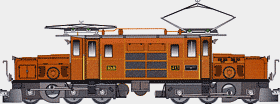  Locomotives Locomotives
In the beginning the various different lines and companies of which the RhB was comprised
used many different types of locomotives, mainly steam. There were probably about 57 steam engines on the RhB before
electrification occurred between 1919 and 1922. These were of various different types from G 3/4 tank engines, 2-8-0
Consolidations, and some Mallet types. Most were disposed of in the 1920s however several have survived and now occasionally find
work hauling special trains.
The smallest electric loco on the RhB is known as a Ge 2/2 of which there are only two in service.
There are twelve small diesel locomotives designated Tmf 2/2 in operation throughout the network that were acquired between
1991 and 2006.
Currently there are only four Ge 4/4 I units remaining in operation.
Still common today are trains handled by the Ge 4/4 II electric locomotives. The Ge 4/4 II units were built in 1973 and
1984. There are 23 in service.
The Ge 4/4 III are used on the Glacier Express but also haul regional passenger
trains. 12 were built between 1989 and 1990. They all carry bright advertising paint schemes.
One of the early electric locomotives found on the RhB is the Ge 6/6 I better known as a Krokodil. A total of 15 were constructed
between 1921 and 1929. As the RhB electrified they replaced the steam locomotives. The Krokodils started to be taken out of
service in 1974 with the last seeing regular operation in 1993. Two are preserved while number 415 is used to pull the Alpine
Classic Pullman Express train today.
Seven Ge 6/6 II's replaced the Krokodils after 1993.
RhB also operates a number of cab control type railcars which can be used in tandem with Ge 4/4 II and
Ge 4/4 IIIs.

The Abe 8/12, or Allegra, is a dual-voltage railcar built by Stadler. The first five railcars, which had been operating mainly over the
Bernina Pass since May 2010, now cover routes from Chur to Arosa and also to Davos. The purchase of these new railcars was to
increase the carrying capacity and operating efficiency of the railway. The new railcars include disabled access, air
conditioning, and integrated IT systems. They can operate on both DC and AC power with the changeover carried out while the train
is in motion passing Pontresina which marks the limit between the main 11 Kilo Volt AC network and the 1,000 Volt DC Bernina Line.
These railcars are suitable for pulling passengers, freight, and special trains. Another five railcars on order for urban lines
are expected to be in operation from spring 2012 onwards.
 The Glacier Express The Glacier Express
 The Glacier Express
operates over a route between Zermatt in the west of Switzerland and St. Moritz in the east. You may ride the trains in either
direction. While the coaches and dining service cars travel the entire route the locomotives pulling the trains change at Disentis
(dis-EN-tees). This is because two different railways operate the trains. On the western portion the Matterhorn Gotthard Bahn
(MGB) pulls the cars while the eastern half of the route is operated by the Rhätische Bahn (RhB). Trains are generally hauled
by rack and adhesion electric locomotives known as model Ge 4/4 III. They were built by SLM, (Schweizerische Lokomotiv und
Maschinenfabrik or Swiss Locomotive and Machine Works) at Winterthur, Switzerland, in 1993. These metre gauge locomotives are
capable of both adhesion and rack operation on the steeper grades along the route. While on the move it's unnoticeable when the
train engages a rack section without stopping. The entire journey from one end to the other takes 7 1/2 hours to traverse 291
bridges and 91 tunnels climbing to an elevation of 2,033 metres (6,670 feet) over the Oberalp Pass. The name "Express"
is a tongue-in-cheek misnomer for the world's slowest fastest train. The Glacier Express
operates over a route between Zermatt in the west of Switzerland and St. Moritz in the east. You may ride the trains in either
direction. While the coaches and dining service cars travel the entire route the locomotives pulling the trains change at Disentis
(dis-EN-tees). This is because two different railways operate the trains. On the western portion the Matterhorn Gotthard Bahn
(MGB) pulls the cars while the eastern half of the route is operated by the Rhätische Bahn (RhB). Trains are generally hauled
by rack and adhesion electric locomotives known as model Ge 4/4 III. They were built by SLM, (Schweizerische Lokomotiv und
Maschinenfabrik or Swiss Locomotive and Machine Works) at Winterthur, Switzerland, in 1993. These metre gauge locomotives are
capable of both adhesion and rack operation on the steeper grades along the route. While on the move it's unnoticeable when the
train engages a rack section without stopping. The entire journey from one end to the other takes 7 1/2 hours to traverse 291
bridges and 91 tunnels climbing to an elevation of 2,033 metres (6,670 feet) over the Oberalp Pass. The name "Express"
is a tongue-in-cheek misnomer for the world's slowest fastest train.
 Alpine Classic Pullman Express Alpine Classic Pullman Express

Travel in vintage 1930s style on a two-day trip through the Swiss Alps aboard the
restored Alpine Classic Pullman cars. Plush upholstery, shining brassware and damask tablecloths characterise
the interior of the dining car on this legendary RhB train. Take a seat aboard the elegant piano car next to bons vivants and lovers of culture.
A trip starts in St. Moritz or Zermatt with carefully programmed stops along the way. Visit the church in Zillis with its
mediaeval frescoes, enjoy a walk around Eggishorn in the UNESCO natural heritage site of Aletsch, or explore the historical
quarter of Chur, the oldest town in Switzerland. Stay overnight in Andermatt at a cosy mountain inn with the next day's journey
pulled by the famous Krokodil locomotive.
Items with this Special Trip Include:
· Rail travel from Zermatt to St. Moritz or vice versa;
· (The Zermatt to Disentis section is on the Matterhorn Gotthard Railway);
· A visit to the Disentis monastery;
· Lunch aboard the dining car including drinks served with meal;
· A trip by steam train on the Furka mountain line (DFB);
· Overnight stay in Andermatt with evening meal and drinks;
· An excursion to Eggishorn with lunch;
· A city tour of Chur;
· Bus transfers for excursions;
· Accompanied by an expert guide with travel literature supplied.
The flat-rate fare is only 1,250 francs ($1,525) per person. Single-room supplement 50 francs
($61).
 News Articles News Articles
17 Dec 2009 - Rhätische Bahn Orders Diesel Locomotives at Schalke
23 Jul 2010 - One Dead Dozens Injured in Swiss Tourist Train Derailment
30 Jul 2010 - Human Error Caused Glacier Express Crash
26 Dec 2010 - Canada-Switzerland Connection's On
Track
 LGB Model LGB Model
LGB is the acronym
and trademark for Lehmann Gross Bahn model trains made by Ernst Paul Lehmann Patentwerk in Nuremberg, Germany, since 1968 and by
Märklin since 2007. LGB caused a revival of garden model railroading in North America when it was introduced. It is now known
as "G" scale to model railroaders. This Rhätische Bahn Ge 4/4 II electric locomotive comes with the paint
scheme occasioned by the 100th anniversary of the Bernina line. The model was produced as a one-time event for the anniversary. It
has extensive features such as multi-train control and sound functions. The locomotive pantographs can be raised and lowered
electrically, and it has cab lighting. It is equipped with 2 motors and traction tires. The model weighs over 9 pounds with a
length over buffers of approximately 22 1/2 inches. The initial shipment of the model was on 22 Dec 2010.
 Associated Web Sites Associated Web Sites
Rhätische Bahn
The Glacier Express
Historic RhB
Association Pro Salon RhB
DFB (Dampfbahn Furka Bergstrecke)
Stadler
Steam on the Rhätische Bahn
The Rhätische Bahn Steam Snowblower
Steam Friends Society of the Rhaetian Railway
Bahnmuseum Albula
Club 1889
|

